#Industrial generator manufactures in the UK
Explore tagged Tumblr posts
Text

Industrial generator manufactures in the UK are also contributing to such targets by leading the Green Generator Movement. If you’re wondering how modern day industrial generators in the UK contribute to greenhouse gases, then here is a fun fact.
A typical diesel generator produces around 1-2 pounds of carbon dioxide per hour of operation at a quarter of its maximum load.
0 notes
Text
"The amount of electricity generated by the UK’s gas and coal power plants fell by 20% last year, with consumption of fossil fuels at its lowest level since 1957.
Not since Harold Macmillan was the UK prime minister and the Beatles’ John Lennon and Paul McCartney met for the first time has the UK used less coal and gas.
The UK’s gas power plants last year generated 31% of the UK’s electricity, or 98 terawatt hours (TWh), according to a report by the industry journal Carbon Brief, while the UK’s last remaining coal plant produced enough electricity to meet just 1% of the UK’s power demand or 4TWh.
Fossil fuels were squeezed out of the electricity system by a surge in renewable energy generation combined with higher electricity imports from France and Norway and a long-term trend of falling demand.
Higher power imports last year were driven by an increase in nuclear power from France and hydropower from Norway in 2023. This marked a reversal from 2022 when a string of nuclear outages in France helped make the UK a net exporter of electricity for the first time.
Carbon Brief found that gas and coal power plants made up just over a third of the UK’s electricity supplies in 2023, while renewable energy provided the single largest source of power to the grid at a record 42%.
It was the third year this decade that renewable energy sources, including wind, solar, hydro and biomass power, outperformed fossil fuels [in the UK], according to the analysis. Renewables and Britain’s nuclear reactors, which generated 13% of electricity supplies last year, helped low-carbon electricity make up 55% of the UK’s electricity in 2023.
[Note: "Third year this decade" refers to the UK specifically, not global; there are several countries that already run on 100% renewable energy, and more above 90% renewable. Also, though, there have only been four years this decade so far! So three out of four is pretty good!]
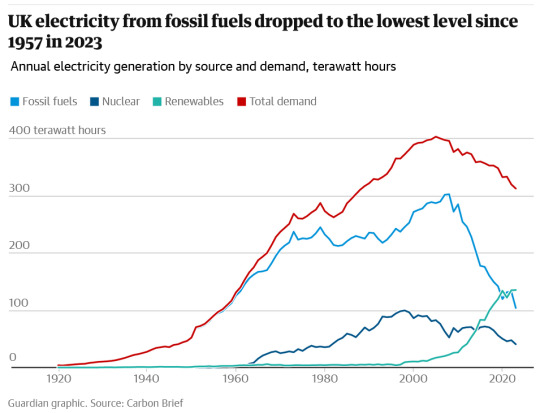
Dan McGrail, the chief executive of RenewableUK, said the data shows “the central role that wind, solar and other clean power sources are consistently playing in Britain’s energy transition”.
“We’re working closely with the government to accelerate the pace at which we build new projects and new supply chains in the face of intense global competition, as everyone is trying to replicate our success,” McGrail said.
Electricity from fossil fuels was two-thirds lower in 2023 compared with its peak in 2008, according to Carbon Brief. It found that coal has dropped by 97% and gas by 43% in the last 15 years.
Coal power is expected to fall further in 2024 after the planned shutdown of Britain’s last remaining coal plant in September. The Ratcliffe on Soar coal plant, owned by the German utility Uniper, is scheduled to shut before next winter after generating power for over 55 years.
Renewable energy has increased sixfold since 2008 as the UK has constructed more wind and solar farms, and the large Drax coal plant has converted some of its generating units to burn biomass pellets.
Electricity demand has tumbled by 22% since its peak in 2005, according to the data, as part of a long-term trend driven by more energy efficient homes and appliances as well as a decline in the UK’s manufacturing sector.
Demand for electricity is expected to double as the UK aims to cut emissions to net zero by 2050 because the plan relies heavily on replacing fossil fuel transport and heating with electric alternatives.
In recent weeks [aka at the end of 2023], offshore wind developers have given the green light to another four large windfarms in UK waters, including the world’s largest offshore windfarm at Hornsea 3, which will be built off the North Yorkshire coast by Denmark’s Ørsted."
-via The Guardian, January 2, 2024
#uk#united kingdom#england#scotland#wales#northern ireland#electricity#renewables#renewable energy#climate change#sustainability#hope posting#green energy#fossil fuels#oil#coal#solar power#wind power#environment#climate action#global warming#air pollution#climate crisis#good news#hope
394 notes
·
View notes
Text
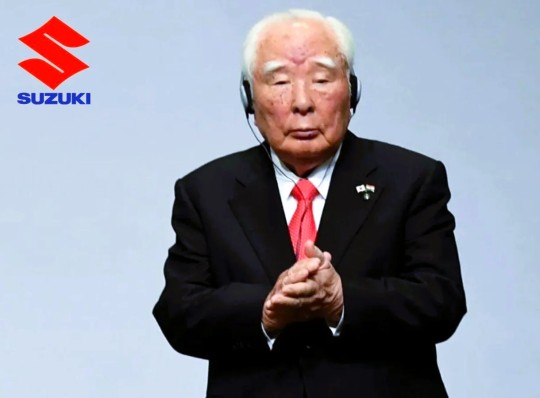
Osamu Suzuki
Suzuki chairman who over half a century grew the company into one of the world’s largest car and motorcycle manufacturers
Osamu Suzuki, who has died aged 94, was one of the global automotive industry’s longest serving leaders. A director since 1963 of Suzuki, the motorcycle and small car manufacturer based in Hamamatsu, Japan, he rose through the ranks to become in 1979 the firm’s president, a position he relinquished only in 2019 to ascend to the chairmanship. Latterly, as is customary with elder statemen of Japanese industry, he became an adviser, the title he still held at the time of his death.
When he first joined Suzuki, in 1958, it had been in the automobile business for only four years, building the tiny two-cylinder, air-cooled Suzulight car, in a country that was still finding its way as an industrial power. It had been founded in 1909 as a loom manufacturer, but the collapse of the cotton market in the early 1950s galvanised a move towards automotive endeavours.
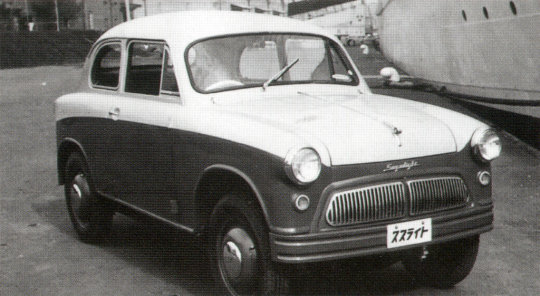
Suzuki produced its first motorcycle – really a 36cc motorised pedal bike – in 1952 but 10 years later would notch up its first Isle of Man TT victory. In 1976, Barry Sheene won his first 500cc World Championship on a Suzuki RG500. The loom-making arm of the firm was separated from the automotive side in 1960 and, under Osamu, Suzuki expanded into the production of outboard motors, wheelchairs, all-terrain vehicles, and prefabricated housing.
He progressed conservatively to make Suzuki the largest small car producer in Japan, always with a keen eye on cost cutting, even on a shop-floor level: in one plant he famously had some of the light bulbs removed to save $40,000 on electricity.
Suzuki motorcycles arrived in the UK long before its cars, alongside Honda and others helping decimate the British motorcycle industry from the mid-60s onwards with dependable, easy to maintain two-wheeled machinery.
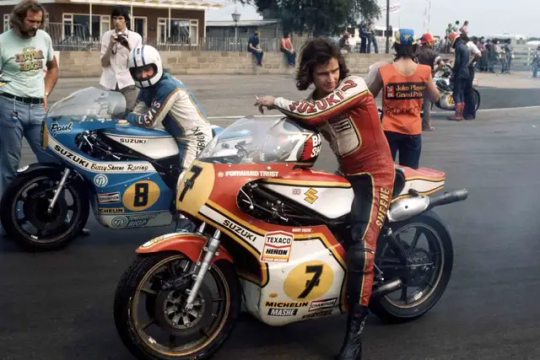
The now collectable Whizzkid Coupe and Jimny off-roader (sold in the UK as the Satana and Samurai) were relative latecomers to the Japanese car sales bonanza from 1979. The Suzuki Alto of the early 80s was the cheapest automatic car then available in the UK, priced at £4,000, while the 1985 Swift was the firm’s first four-cylinder “supermini” sized vehicle.
The Bedford Rascal – better known as the “Sooty van” in the TV puppet series Sooty and Sweep – was really a rebadged Suzuki Carry, or “kei” truck, built to conform to strict Japanese light commercial specifications. These Rascal/Carry trucks were a spin-off from a deal that Osamu Suzuki struck with General Motors in 1981 to sell its economy cars in North America with Chevrolet badges, in return for giving GM a 5% stake in the company.
Osamu would also preside in 2009 over a tie-up with VW that ended in a court battle, and latterly collaborated with Toyota on the design of self-driving cars.
From the late 60s, production of the small Fronte rear-engined cars ramped up under Osamu’s leadership but, unlike its rivals, Nissan, Toyota and Mazda, Suzuki did not give in to the temptation to move upmarket, preferring to use its resources to build satellite plants in emerging markets where its small runabout cars had most appeal.
Beginning in Thailand in 1967 – and followed by Indonesia, the Philippines, Australia and Pakistan in the 70s and 80s – Suzuki expanded its operations on the Pacific rim rather than tackle local rivals head on, although between 1967 and 1970 Japanese production rose substantially, based at four new locations.
In the early 80s Suzuki became the first Japanese manufacturer to establish a manufacturing outlet in India, where its new front-wheel drive Alto/Fronte broke the stranglehold of the outdated Hindustan ambassador (a locally built 1950s Morris Oxford), and the equally ancient Fiat 1100-based Premier Padmini to become the bestselling car in India. Osamu Suzuki made over 200 flights to India in an effort to get this historic deal done.
By the beginning of the 2000s Suzuki had 60 factories in 31 countries as sales rose tenfold to a value of $19bn.
The son of Toshiki and Matsuda Shunzo, and born in the city of Gero, Gifo Prefecture, in central Japan, Osamu graduated in law from Chuo University in Tokyo in 1953 and worked in the loans office of a local bank before joining Suzuki in 1958. Around the same time, he married Shoko Suzuki, the granddaughter of the company’s founder, and, as per local tradition when there is no male heir, adopted his wife’s family name.
Had Hirotaka Ono, the son-in-law he had been grooming to take his place, not died of cancer in 2007, Osamu would probably have enjoyed a much longer retirement. A keen golfer into his 90s, five years ago he handed the reigns of the company to his son Toshihiro, the eldest of his three children.
🔔 Osamu Suzuki, industrialist, born 30 January 1930; died 25 December 2024
Daily inspiration. Discover more photos at Just for Books…?
12 notes
·
View notes
Text
National personification
The UK has Britannia. France has Marianne. The US have Uncle Sam. National personifications, summing up supposed collective qualities and passing on a message, both to citizens and foreigners alike. Instantly recognizable by just about anyone. To be found everywhere, from city halls (busts, frescoes, tapestries) to subway walls (Army conscription posters - of course it rings a bell!).
Romania has this:

This is Revolutionary Romania, as seen by C.D. Rosenthal, an Austrian painter who found both friendship and an avid clientele among the Romanian young rebels who tried and failed to overthrow the corrupted Ottoman rule, in 1848. Following them in exile and probably also spying on their behalf, Rosenthal was finally arrested in Budapest and tortured to death by the Imperial authorities: a normal occurrence in troubled times. His memory went on and on and on, because the same friends were soon to come back home and become ministers, bankers, newspaper owners: a modern democracy slowly emerged.
This is his most famous portrait and it quickly became our Britannia of sorts. Ceaușescu had it placed in his office, for inspiration - it did not help much, though.
The woman painted by Rosenthal holds the red, yellow and blue flag and is dressed in a Southern peasant costume, as it was worn at the time. She gazes with strength, determination and confidence towards a future that spells free press, parliamentary elections, industrialization and capitalist speculation. In real life, she is Maria Rosetti, a personal friend and sponsor of his. The wife of C.A. Rosetti, an authentic Prince of Genoese and Greek stock, one of the leaders of both the rebellion and the future Liberal Party. Also a many times removed relative of this blogger - but let's not insist. 😉
There is a catch, however, in all this fine and dandy story. Our national personification, the woman I just mentioned, is Scottish. Her life begins in Guernsey in 1819, as Marie Grant, the daughter of Captain Edward Grant, a ship-owner businessman and member of the Clan Grant of Carron and Spey and Marie La Lacheur, a French Huguenot woman.
These people, who fought as Jacobites at Prestonpans and Culloden and whose motto was 'Stand Fast':


Marie came to Wallachia, or what is now the Southern part of Romania, around 1837, following her younger brother, Effingham Grant, who just managed to find a lucrative job as the private secretary of another Scot (Glaswegian, even), Robert Gilmour Colquhoun, the newly appointed British Consul-General. At the time, these were long term postings, not unlike a long sojourn on a space station of sorts: Colquhoun remained in Bucharest from 1835 to 1854, when he eventually was posted to Bosnia.
Because she needed to support herself, Marie found a well paid live-in job as a governess for the family of Ion Odobescu, a high ranking Police honcho (also a far removed relative, this time on my maternal grandmother's side - the world is really, really small). The rest was easy enough: having met Rosetti through her brother, they fell in love, eloped to Plymouth and got married there, for what was to become a life long equal political and business partnership. Because they owned several newspapers, she is our first female journalist. A truly remarkable woman, a philanthropist and an indispensable voice advocating for the dispossessed. Effingham went on to establish the biggest foundry in the country, along with a real estate company, a tobacco manufacture, an orchid greenhouse and a bread factory - all prospered beyond any expectations. A heavy traffic steel bridge in Bucharest still bears his name. Enduring legacies.
For those brave enough or bored enough to look for more, here is the best detailed account on her I could find, based on Guernsey sources (but not only): https://www.priaulxlibrary.co.uk/node/386 .
36 notes
·
View notes
Text

I.3.8 Do anarchists seek “small autonomous communities, devoted to small scale production”?
No. The idea that anarchism aims for small, self-sufficient, communes is a Leninist slander. They misrepresent anarchist ideas on this matter, suggesting that anarchists seriously want society based on “small autonomous communities, devoted to small scale production.” In particular, they point to Kropotkin, arguing that he “looked backwards for change” and “witnessed such communities among Siberian peasants and watchmakers in the Swiss mountains.” [Pat Stack, “Anarchy in the UK?”, Socialist Review, no. 246] Another Leninist, Donny Gluckstein, makes a similar assertion about Proudhon wanting a federation of “tiny economic units”. [The Paris Commune, p. 75]
While it may be better to cover this issue in section H.2, we discuss it here simply because it relates directly to what an anarchist society could look like and so it allows us to that more fully.
So what do anarchists make of the assertion that we aim for “small autonomous communities, devoted to small scale production”? Simply put, we think it is nonsense (as would be quickly obvious from reading anarchist theory). Indeed, it is hard to know where this particular anarchist “vision” comes from. As Luigi Fabbri noted, in his reply to an identical assertion by the leading Bolshevik Nikolai Bukharin, ”[i]t would be interesting to learn in what anarchist book, pamphlet or programme such an ‘ideal’ is set out, or even such a hard and fast rule!” [“Anarchy and ‘Scientific’ Communism”, pp. 13–49, The Poverty of Statism, Albert Meltzer (ed.), p. 21]
If we look at, say, Proudhon, we soon see no such argument for “small scale” production. For Proudhon, ”[l]arge industry … come to us by big monopoly and big property: it is necessary in the future to make them rise from the [workers] association.” [quoted by K. Steven Vincent, Proudhon and the Rise of French Republican Socialism, p. 156] In fact, The Frenchman explicitly rejected the position Stack inflicts on him by arguing that it “would be to retrograde” and “impossible” to wish “the division of labour, with machinery and manufactures, to be abandoned, and each family to return to the system of primitive indivision, — that is, to each one by himself, each one for himself, in the most literal meaning of the words.” [System of Economic Contradictions, p. 206] As historian K. Steven Vincent correctly summarises:
“On this issue, it is necessary to emphasise that, contrary to the general image given in the secondary literature, Proudhon was not hostile to large industry. Clearly, he objected to many aspects of what these large enterprises had introduced into society. For example, Proudhon strenuously opposed the degrading character of … work which required an individual to repeat one minor function continuously. But he was not opposed in principle to large-scale production. What he desired was to humanise such production, to socialise it so that the worker would not be the mere appendage to a machine. Such a humanisation of large industries would result, according to Proudhon, from the introduction of strong workers’ associations. These associations would enable the workers to determine jointly by election how the enterprise was to be directed and operated on a day-to-day basis.” [Op. Cit., p. 156]
Moreover, Proudhon did not see an anarchist society as one of isolated communities or workplaces. Like other anarchists, as we discussed in section I.3.4, Proudhon saw a free society’s productive activity centred around federations of syndicates.
This vision of a federation of workplaces can also be found in Bakunin’s writings: “The future organisation of society must proceed from the bottom up only, through free association or federations of the workers, into their associations to begin with, then into communes, regions, nations and, finally, into a great international and universal federation.” [No Gods, No Masters, vol. 1, p. 176] Like Proudhon, Bakunin also explicitly rejected the idea of seeking small-scale production, arguing that “if [the workers] tried to divide among themselves the capital that exists, they would … reduce to a large decree its productive power.” Therefore the need was for “the collective property of capital” to ensure “the emancipation of labour and of the workers.” [The Basic Bakunin, p. 91] Bakunin, again like Proudhon, considered that ”[i]ntelligent free labour will necessarily be associated labour” as under capitalism the worker “works for others” and her labour is “bereft of liberty, leisure and intelligence.” Under anarchism, “the free productive associations” would become “their own masters and the owners of the necessary capital” and “amalgamate among themselves” and “sooner or later” will “expand beyond national frontiers” and “form one vast economic federation.” [Michael Bakunin: Selected Writings, pp. 81–3]
Nor can such a vision be attributed to Kropotkin. While, of course, supporting decentralisation of power and decision making as did Proudhon and Bakunin, he did not reject the necessity of federations to co-ordinate activity. As he put it, the “commune of tomorrow will know that it cannot admit any higher authority; above it there can only be the interests of the Federation, freely accepted by itself as well as the other communes”/ For anarchists the commune “no longer means a territorial agglomeration; it is rather a generic name, a synonym for the grouping of equals which knows neither frontiers nor walls … Each group in the Commune will necessarily be drawn towards similar groups in other communes; they will come together and the links that federate them will be as solid as those that attach them to their fellow citizens.” [Words of a Rebel, p. 83 and p. 88] Nor did he reject industry or machinery, stating he “understood the poetry of machinery” and that while in “our present factories, machinery work is killing for the worker” this was “a matter of bad organisation, and has nothing to do with the machine itself.” [Memiors of a Revolutionist, p. 111]
Kropotkin’s vision was one of federations of decentralised communities in which production would be based on the “scattering of industries over the country — so as to bring the factory amidst the fields … agriculture … combined with industry … to produce a combination of industrial with agricultural work.” He considered this as “surely the next step to be made, as soon as a reorganisation of our present conditions is possible” and “is imposed by the very necessity of producing for the producers themselves.” [Fields, Factories and Workshops Tomorrow, pp. 157–8] He based this vision on a detailed analysis of current economic statistics and trends.
Kropotkin did not see such an anarchist economy as being based around the small community, taking the basic unit of a free society as one “large enough to dispose of a certain variety of natural resources — it may be a nation, or rather a region — produces and itself consumes most of its own agricultural and manufactured produce.” Such a region would “find the best means of combining agriculture with manufacture — the work in the field with a decentralised industry.” Moreover, he recognised that the “geographical distribution of industries in a given country depends … to a great extent upon a complexus of natural conditions; it is obvious that there are spots which are best suited for the development of certain industries … The[se] industries always find some advantages in being grouped, to some extent, according to the natural features of separate regions.” [Op. Cit., p. 26, p. 27 and pp. 154–5]
Kropotkin stressed that agriculture “cannot develop without the aid of machinery and the use of a perfect machinery cannot be generalised without industrial surroundings … The village smith would not do.” He supported the integration of agriculture and industry, with “the factory and workshop at the gates of your fields and gardens” in which a “variety of agricultural, industrial and intellectual pursuits are combined in each community” to ensure “the greatest sum total of well-being.” He thought that “large establishments” would still exist, but these would be “better placed at certain spots indicated by Nature.” He stressed that it “would be a great mistake to imagine industry ought to return to its hand-work stage in order to be combined with agriculture. Whenever a saving of human labour can be obtained by means of a machine, the machine is welcome and will be resorted to; and there is hardly one single branch of industry into which machinery work could not be introduced with great advantage, at least at some of the stages of the manufacture.” [Op. Cit., p. 156, p. 197, p. 18, pp. 154–5 and pp. 151–2]
Clearly Kropotkin was not opposed to large-scale industry for “if we analyse the modern industries, we soon discover that for some of them the co-operation of hundred, even thousands, of workers gathered at the same spot is really necessary. The great iron works and mining enterprises decidedly belong to that category; oceanic steamers cannot be built in village factories.” However, he stressed that this objective necessity was not the case in many other industries and centralised production existed in these purely to allow capitalists “to hold command of the market” and “to suit the temporary interests of the few — by no means those of the nation.” Kropotkin made a clear division between economic tendencies which existed to aid the capitalist to dominate the market and enhance their profits and power and those which indicated a different kind of future. Once we consider the “moral and physical advantages which man would derive from dividing his work between field and the workshop” we must automatically evaluate the structure of modern industry with the criteria of what is best for the worker (and society and the environment) rather than what was best for capitalist profits and power. [Op. Cit., p. 153, p. 147 and p. 153]
Clearly, Leninist summaries of Kropotkin’s ideas on this subject are nonsense. Rather than seeing “small-scale” production as the basis of his vision of a free society, he saw production as being geared around the economic unit of a nation or region: “Each region will become its own producer and its own consumer of manufactured goods … [and] its own producer and consumer of agricultural produce.” Industry would come to the village “not in its present shape of a capitalist factory” but “in the shape of a socially organised industrial production, with the full aid of machinery and technical knowledge.” [Op. Cit., p. 40 and p. 151]
Industry would be decentralised and integrated with agriculture and based around communes, but these communes would be part of a federation and so production would be based around meeting the needs of these federations. A system of rational decentralisation would be the basis of Kropotkin’s communist-anarchism, with productive activity and a free society’s workplaces geared to the appropriate level. For those forms of industry which would be best organised on a large-scale would continue to be so organised, but for those whose current (i.e., capitalist) structure had no objective need to be centralised would be broken up to allow the transformation of work for the benefit of both workers and society. Thus we would see a system of workplaces geared to local and district needs complementing larger factories which would meet regional and wider needs.
Anarchism rejects the idea of small-scale production and isolated communes and, as we discussed in section H.2.3, it does not look backwards for its ideal. The same applies to other forms of libertarian socialism with, for example, G.D.H. Cole arguing that we “cannot go back to ‘town economy’, a general regime of handicraft and master-craftmanship, tiny-scale production. We can neither pull up our railways, fill our mines, and dismantle our factories nor conduct our large-scale enterprises under a system developed to fit the needs of a local market and a narrowly-restricted production.” The aim is “to reintroduce into industry the communal spirit, by re-fashioning industrialism in such a way as to set the communal motives free to co-operate.” [Guild Socialism Reststed, pp. 45–6 and p. 46]
The obvious implication of Leninist comments arguments against anarchist ideas on industrial transformation after a revolution is that they think that a socialist society will basically be the same as capitalism, using the technology, industry and industrial structure developed under class society without change (as noted in section H.3.12, Lenin did suggest that was the case). Needless to say, capitalist industry, as Kropotkin was aware, has not developed neutrally nor purely because of technical needs. Rather it has been distorted by the twin requirements to maintain capitalist profits and power. One of the first tasks of a social revolution will be to transform the industrial structure, not keep it as it is. You cannot use capitalist means for socialist ends. So while we will “inherent” an industrial structure from capitalism it would be the greatest possible error to leave it unchanged and an even worse one to accelerate the processes by which capitalists maintain and increase their power (i.e. centralisation and concentration) in the name of “socialism.”
We are sorry to have laboured this point, but this issue is one which arises with depressing frequency in Marxist accounts of anarchism. It is best that we indicate that those who make the claim that anarchists seek “small scale” production geared for “small autonomous communities” simply show their ignorance. In actually, anarchists see production as being geared to whatever makes most social, economic and ecological sense. Some production and workplaces will be geared to the local commune, some will be geared to the district federation, some to the regional federation, and so on. It is for this reason anarchists support the federation of workers’ associations as the means of combining local autonomy with the needs for co-ordination and joint activity. To claim otherwise is simply to misrepresent anarchist theory.
Finally, it must be psychologically significant that Leninists continually go on about anarchists advocating “small” and “tiny” workplaces. Apparently size does matter and Leninists think their productive units are much, much bigger than anarchist ones. As has been proven, anarchists advocate appropriately sized workplaces and are not hung-up about their size. Why Leninists are could be a fruitful area of research...
#anarchist society#practical#practical anarchism#practical anarchy#faq#anarchy faq#revolution#anarchism#daily posts#communism#anti capitalist#anti capitalism#late stage capitalism#organization#grassroots#grass roots#anarchists#libraries#leftism#social issues#economy#economics#climate change#climate crisis#climate#ecology#anarchy works#environmentalism#environment#solarpunk
7 notes
·
View notes
Text
China is facing the prospect of further G7 sanctions.
The G7 has accused it of helping arm Russia against Ukraine.
Balancing its support for Russia with its European trading ties is becoming tricky for China.
NATO Secretary General Jens Stoltenberg this week warned China it faces a stark choice if it continues backing Russia's Ukraine invasion.
"Publicly, President Xi has tried to create the impression that he's taking a back seat in this conflict to avoid sanctions and keep trade flowing," Stoltenberg said.
"But the reality is that China's fueling the largest armed conflict in Europe since World War II.
"At the same time, it wants to maintain good relations with the West.
"Well, Beijing cannot have it both ways. At some point, and unless China changes course, allies need to impose a cost."
A tough stance
The remarks are part of a tough new stance from the US and its allies over China's alleged provision of crucial dual-use goods to Russia to fuel the Kremlin's war machine.
The US believes China has supplied Russia with equipment such as chips and integrated circuits, which can be used to produce weapons. In response, China has said it is not a party to the Ukraine war and that there should be no interference with trade between China and Russia.
At the G7 summit last weekend, the leaders unambiguously signaled their growing frustration with China in a joint statement. "China's ongoing support for Russia's defense industrial base is enabling Russia to maintain its illegal war in Ukraine and has significant and broad-based security implications," said the leaders of some of the world's biggest advanced economies.
It came days after the European Commission told Chinese carmakers that it would provisionally apply duties of up to 38% on imported Chinese electric vehicles from next month.
And in April and May, the US imposed new sanctions on Chinese banks and companies it accused of supplying goods and services for the Russian military.
Xi's balancing act
Analysts say that China is performing a balancing act. It is backing the Russian invasion to dent US global power while also seeking to maintain the trading ties with Europe its economy depends on.
The US has long been pushing its European allies to adopt a tougher stance toward Beijing similar to its own.
But they have hesitated until now. Many retain close economic ties with China, with the European economic giant Germany long dependent on China's manufacturing might for products such as cars and electronic devices.
But at the G7 there were signs that might be about to change, and Europe's leaders are becoming increasingly exasperated with China.
In the statement, members said they were willing to punish Beijing further for its support of Russia.
"We will continue taking measures against actors in China and third countries that materially support Russia's war machine, including financial institutions, consistent with our legal systems," they said.
China-Europe tensions increase
It's not just China's support for Russia that appears to be focusing European minds on the potential threat it poses.
In recent months, authorities in Germany and the UK have arrested people accused of spying for China, and the European Union has accused Beijing of flooding markets with cheap electronic cars.
China has sought to exploit divisions in Europe, with Xi visiting Hungary and Serbia in May, just after visiting France's President Emanuel Macron. Both have taken a critical stance towards Ukraine and appear keen to do more business with China, in defiance of EU policy. And China also seems keen to drive a wedge between European countries and the US.
But China's attempts to sustain its balancing act appear to be getting more difficult to sustain.
A person familiar with G7 talks told the Financial Times: "The era of naivety towards Beijing is definitely gone now and China is to blame for that, honestly."
5 notes
·
View notes
Text
no one
1. The Longest Masturbation Session
In 2009, Masanobu Sato won the endurance competition at the annual Masturbate-a-thon fundraiser hosted by San Francisco’s Center for Sex & Culture, an event that first surfaced in the ‘90s to destigmatize solo sex and self-pleasure. What was Sato’s time, you ask? A whopping nine hours and 33 minutes.
Today, however, Sato faces some stiff competition. According to Mel Magazine, 43-year-old Drake Hardy, a “bisexual man with a master’s degree in physical sciences,” is gearing up to break the world record, which has since increased to 10 hours and 10 minutes. Workin’ hard or hardly workin’, eh Drake?
2. The Most Orgasms In One Hour
According to a blog post from sex toy manufacturer Lelo, doctors from the Center for Marital and Sexual Studies in California once observed 134 orgasms from a single woman in one hour — the most ever documented. By contrast, the record for men stands at a measly 16 orgasms in the same length of time.
Similarly, in 1966, a woman experienced the longest orgasm on record. It reportedly lasted for 45 seconds and resulted in 25 individual contractions. Sounds like she came for a good time and a long time.
3. The Oldest Pair Of Twin Sex Workers
In 2012, Martine and Louise Fokken, then 70-year-old identical twin sisters and long-time sex workers in Amsterdam’s Red Light District, released their memoirs and a documentary film about their lives entitled Meet The Fokkens, according to the BBC. The Fokken sisters are widely considered to be the oldest twin sex workers in the business, not only in Amsterdam, where prostitution is legal, but anywhere in the world. BRB, buying tickets for Sister Act 2: Fokken Me Up, coming to a theater near you.
Additional elderly escorts include a Taipei woman in her 80’s nicknamed “Grandma” and Sheila Vogel-Coupe, considered to be Britain’s oldest prostitute, who is now in her early 90’s.
4. The Largest Natural Breasts

Annie Hawkins-Turner, better known as Norma Stitz (aka enormous t*ts), is the Atlanta-based fetish model and entrepreneur who’s held the Guinness world record for largest breasts since 1999. Now in her 60’s, Hawkins-Turner’s bra size is a 102ZZZ and it’s speculated that each breast weighs anywhere between 55 and 85 pounds. In 2011, Hawkins-Turner appeared on the UK’s This Morning to speak about her experience growing up with such a prominent chest, for which she’s been the victim of relentless bullying and teasing from strangers practically all her life. Of her work in the fetish industry, she told the show’s hosts, “I've shown people that big is beautiful and you can be sexy in your own way.” Team Norma forever.
5. Most Sexual Partners In A 24-Hour Period
The holder of this record is widely considered to be porn star Lisa Sparks (also known as Lisa Sparxxx), who — at an event in Warsaw, Poland — reportedly had sex with 919 individual men back-to-back within a period of 24 hours. No one seems to have been able to out-bang Sparxxx since that fateful day in 2004, so she remains the reigning champ. And frankly, it’s a tall order — there’s not enough lube in the entire solar system to keep the chafing from 900+ partners at bay. We salute you and your steel vagina, Ms. Sparxxx.
6. The Oldest Male Pornstar
At 60, Tokyo-born Shigeo Tokuda retired from his desk job as a travel agent and took up something a little more stimulating: Porn. Now well into his 80’s, Tokuda has starred in more than 350 adult films and is widely considered the “undisputed king of Japanese mature porn.” Flex, king.
7. The Oldest Virgin
In 2011, UK-born secretary Clara Meadmore died a proud virgin just before turning 108. During a public celebration of her 107th birthday, Meadmore reportedly told the press that the key to her longevity was her abstinence. To Meadmore, sex and intimate relationships seemed like “a lot of hassle.” Maybe she was onto something… *texts ex*.
8. The Biggest Collection of Penises
If you’ve got a yen for general erotic art, The World Erotic Art Museum, located in Miami Beach, has thousands of works for you to browse. But if you’re looking specifically for a collection of more than 200 penises, you’re going to need to head to the Icelandic Phallological Museum in Reykjavik, Iceland. You’ll see whale penises, you’ll see fox penises, you’ll see penises belonging to characters from Icelandic folklore. This is your one-stop phallus shop. Bring your own condoms.
9. The Largest Orgy
The world record for the largest orgy was broken back in 2006 when 500 naked, writhing bodies came together (in more ways than one) for a sex session in Japan. Since then, the record-holders have proven difficult to de-throne. According to Men’s Health, “Menage Life's Sin City 8 sex festival endeavored to hold the world's largest orgy” in 2018, but logistical difficulties resulted in a sub-par total of 375 people. Better luck next time.
10. The Longest Marriage
Warning: Painfully sweet content ahead! Zelmyra Fisher, born in 1907, and her husband Herbert Fisher, born in 1905, sealed the deal on May 13, 1924 in North Carolina and remained married until Fisher’s death in 2015. According to the Guinness Book of World Records, the two had been married 86 years, 9 months, and 16 days as of February 27, 2011. Mawwiage indeed!
11. Most Queefs In 30 Seconds
For those who are less literate in yonic expulsions, a queef is a form of vaginal flatulence, usually accompanied by a fart sound, that escapes the vagina when built-up air pressure is released, especially after or during sex.
In 2009, Howard Stern held a queefing championship, and the results seem to defy all logic and scientific principles. Abby, the winner, reportedly let 93 queefs rip in just one minute for an average of three per second. Truly, an amazing feat. All hail Chief Queef.
12. The Strongest Vagina

13. The Largest Penis
There’s a bit of a dispute about who is the true holder of this coveted record. For many years, New Yorker Jonah Falcon was considered to have the world’s largest penis, clocking in at 9.5 inches flaccid and 13.5 inches when erect. However, in recent years, a challenger from Mexico has come forth named Roberto Esquivel Cabrera, who claims to be the proud owner of a 19-incher. Go long, boys.
14. World’s Longest Kiss
According to Guinness, the longest kiss on record lasted a staggering 58 hours, 35 minutes, and 58 seconds. The love birds in question? Thailand’s own Ekkachai Tiranarat and Laksana Tiranarat. They completed the smooch at an event organized by Ripley's Believe It or Not! in Pattaya, Thailand in 2013. Talk about a marathon makeout sesh.
15. Longest Ejaculation By Distance
The official number on record is 18 feet, 9 inches, reportedly spewed from an American man by the name of Horst Schultz. However, according to a recent Mel Magazine article, these numbers are completely unsubstantiated. It’s not even clear if this Horst Schultz character is a real person or just an urban legend — an Abominable Sperm-man, if you will.
Whether or not he and his record are legit, the lore of Schultz’s ejaculate has inspired one anonymous 35-year-old North Hollywood man to shoot for the stars — or at least the other side of the room. The man, whom Mel Magazine called “Matthew,” is nothing if not dedicated to his craft. His training has whipped his pelvic floor into “prime shape,” through “various exercises.” He’s also employed “electrical muscle stimulation machines that work via anal probe.” To date, Matthew has passed the 5-foot mark with his sperm. When he reaches six, he reportedly plans to contact the Guinness Book of World Records to finally set the record straight. Far out, dude.
16. Greatest Speed Of Ejaculation
This is another record reportedly held by Mr. Schultz, of ejaculation legend. If the numbers are correct, Schultz is responsible for a jet stream of semen traveling at 42.7 miles per hour. Sir, we’re gonna need to see some license and registration, please.
From octogenarian prostitutes to heavy-lifting vaginas, there’s no shortage of amazing things we can do with our bodies. Clearly, that old saying is true: Everybody really is good at something — even if your special talent is rocketing your semen into space.
DON'T MISS A THING
Be the first to know what's trending, straight from Elite DailyElite DailyUp NextSUBMIT
By subscribing to this BDG newsletter, you agree to our Terms of Service and Privacy Policy
MORE LIKE THIS
The Shoe Theory On TikTok Can Predict Breakups
BY HANNAH KERNSRanking 2023’s New Celebrity Couples By Astrological CompatibilityBY CHELSEA JACKSONDemi Lovato's Dating History Led To Her Pop-Punk Love Story With JutesBY CORINNE SULLIVAN
This article was originally published on 03.26.17
HEALTH & WELLNESS

How Much Do You Really Know About Birth Control? Take This Quiz To Find Out
Written by ERIN KELLY
NOVEMBER 6, 2023
HARUKO HAYAKAWA
We get it: Talking about birth control can be awkward. But it’s incredibly important to have those conversations with a healthcare professional, especially if it’s your first time exploring your birth control options.
So, how do you prep for a conversation about your birth control options? Having a list of questions and concerns can be helpful.
Test your knowledge about combination oral contraceptives (COCs) as a first step to learning more. Birth control pills are one of the most commonly prescribed methods to prevent pregnancy, especially COCs, which contain 2 hormone components — an estrogen and progestin. COCs include low-dose birth control pills. We created this quiz below in partnership with the maker of Lo Loestrin® Fe (norethindrone acetate and ethinyl estradiol tablets, ethinyl estradiol tablets and ferrous fumarate tablets), a low-dose birth control pill that provides pregnancy prevention with the lowest daily dose of estrogen available. Take this quiz to see how much you already know about low-dose birth control options, like Lo Loestrin Fe.
Remember, birth control pills may not be right for everyone. In fact, birth control pills increase the risk of serious side effects, such as blood clots, stroke, and heart attack, which can be fatal. Smoking increases these risks, especially if you are over the age of 35. Therefore, women who smoke and are over age 35 should not use birth control pills, like Lo Loestrin Fe. See below for additional Important Risk Information, including Boxed Warning, for Lo Loestrin Fe.
Once you’re finished, schedule an appointment with your OB/GYN to discuss your new findings and ask if low-dose birth control pills may be right for you.
Question 1
All birth control pills have the same amount of daily estrogen.
True
False
Question 2
Low-dose birth control pills work differently than birth control pills that contain larger amounts of estrogen.
True
False
Question 3
Low-dose birth control pills are less effective when it comes to preventing pregnancy.
True
False
Question 4
Taking Lo Loestrin Fe for pregnancy prevention may result in short, lighter periods.
True
False
Question 5
Lo Loestrin Fe is the only available birth control pill with 10 micrograms of daily estrogen.
True
False
There is a lot to love about Lo Loestrin Fe. Learn more about Lo Loestrin Fe before talking to your doctor by clicking here.
What is Lo Loestrin® Fe (norethindrone acetate and ethinyl estradiol tablets, ethinyl estradiol tablets and ferrous fumarate tablets)?
Lo Loestrin® Fe is a prescription birth control pill used for the prevention of pregnancy. If you are moderately obese, discuss with your healthcare provider whether Lo Loestrin Fe is appropriate for you.
IMPORTANT RISK INFORMATION

Please see the full Prescribing Information, including Boxed Warning, and Patient Information.
You are encouraged to report negative side effects of prescription drugs to the FDA. Visit www.fda.gov/medwatch or call 1-800-FDA-1088.
Brought to you by AbbVie, maker of Lo Loestrin® Fe
US-LOL-230150
9 notes
·
View notes
Text
“The world is governed by very different personages from what is imagined by those who are not behind the scenes.”
Benjamin Disraeli
When the nation overwhelmingly voted the Conservative government out of office they did not expect to be electing Tony Blaire as Prime Minister, but that is exactly what they have done. Sir Keir Starmer may be fronting the new Labour government but it is Tony Blair who is Prime Minister behind the scenes.
The signs were there a year ago for all to see. The Financial Times reported that Starmer had told them:
“Labour should stop trashing Tony Blair - a hate figure for many on the Labour left - especially after pushing the UK into the Iraq war. ‘We have to be proud of that record in government and not be arm’s length about it.’ “ (FT: 07/06/23)
In December the same year we have this headline:
“The moment Keir Starmer revealed himself to be a hardcore Blairite”. (Independent: 12/12/23)
The Blairite government of 1997- 2008 did some good things. Sure Start and adequate funding for the NHS are the most frequently cited examples of good Labour policies. But his list of failures is greater.
He tore up the principle of free university education at the point of delivery and introduced tuition fees. Thanks to Blaire:
Almost 1.8m people owe £50,000 or more in student debt” (BBC News: 02/07/24)
That is a collective student debt of £90,000,000,000.
Blair’s legacy of economic mismanagement goes further and has affected all of us. In 1997, when Blair was elected to office, average income was £15,000 a year, while the average house price was £65,000. When Blair left office in 2007, the average wage had risen to £20,000, but the average house now cost £190,000. In short, under Blair, house prices nearly trebled in price while wages only increased by a third.
The sad fact is, Blair, like governments before and after him, failed to make housing a priority and we are all suffering the price of that policy decision today in the form of a chronic housing shortage, unaffordable rents, and property prices beyond the reach of the vast majority of the population.
At the same time as house prices were rocketing, the Blair government presided over a massive fall in industrial output. Investment Monitor (24/11/20) reported that manufacturing:
…”declined in importance with regard to its role within the British economy faster under Blair than under any previous prime minister. The industry accounted for more than 20% of GDP in 1997; by 2007 – when Blair left Number 10 to be replaced by Gordon Brown – this had fallen to 12.4%, and when Labour were voted out of office in 2010 the figure was 10%.
More importantly, when Blair came to power in 1997, income inequality, after years of Thatcherite policies, was at historically high levels, and relative poverty was on the increase. Despite 11 years of a Blairite Labour government ordinary working people saw little change in their economic position, yet under Blaire the rich and wealthy flourished.
“Income inequality changed little...those on relatively low incomes did a little better than those with incomes just above average. However, those right at the top saw their incomes increase very substantially with the result that, on most measures, overall inequality nudged up slightly.” (Institute for Fiscal Studies: 2013)
In short, under Blairite policies the rich became richer at the expense of ordinary working families.
The Labour Party came into existence to better the lot of working class families. This goal was written down in Clause 4 of the Labour Party Constitution part of which states:
“To secure for the workers by hand or by brain the full fruits of their industry and the most equitable distribution thereof that may be possible upon the basis of the common ownership of the means of production..."
Implicit in the notion of “common ownership” is the equal distribution of the wealth generated by those commonly owned industries. This was one of the binding principles of the Labour Party up until 1995 when Tony Blaire tore up this socialist, egalitarian ideal and replaced it with a bland statement that amounted to little more than a wish list but no clear indication how those wishes were to be achieved. Gone was the commitment to secure for workers just wages, gone was the commitment to nationalization, and gone was the Labour Party's commitment to socialism.
Twelve years after leaving office, Margaret Thatcher was asked what she considered to be her greatest achievement and is famously reported to have replied: "Tony Blaire and New Labour". What she meant by this is that Tony Blaire had abandoned Labours historical commitment to socialism and greater economic equality, and had instead adopted her philosophy of minimum state protection for workers, the pursuit of corporate profit at any cost, the deregulation of the financial industry and the privatisation of public assets.
What resulted was the financial crash of 2008, a massive housing shortage as public bodies were no longer allowed to build houses, the gradual erosion of workers pay while the rich became even richer, and national assets such as water and railways being run for private profit rather than providing a decent public service.
Starmer will pursue the same policies as Blaire because he is an unashamed Blairite: This was Sky news headline on 23/05/23:
“Sir Keir Starmer promises his Labour reform will be like Tony Blair's Clause IV 'on steroids'
So next time you look at our new Prime Minister remember who is the puppet master and who the puppet.
#uk politics#keir starmer#blaire#thatcher#puppet puppet master#socialism#working families#wealthy#public assets#profit#corporations
6 notes
·
View notes
Text
had a nap. am not hungover despite the tequila. final eurovision thoughts roundup in order before i shift back into abbott mode:
juries need to be reworked. its been known for many years at this stage and we can no longer pretend 5 people is a representative sample worth the same weight as the thousands per country who vote. if you tried to use 5 people as a representative sample in any other scenario you'd get laughed out of the room. they aren't eurovision experts, they're not like the panel at a gymnastics competition or something, they're just complete music industry randoms. when the two boards are this disprate it is stark evidence that the juries do not represent the music taste of the country and are given too much weight compared to the thousands of votes. it's like we watched two completely different shows. they're out of touch, corruptable, and value "art value" (ballads) over what the viewing public actually values (being entertained on the entertainment show). it does not prevent bloc/diaspora voting because the juries do that just as much if not more, as we saw last year with the jury corruption scandal. it's just last year they got caught. this may be the straw that broke the camels back with the juries and i hope it is.
käärijä would not have won with the old combined system because despite getting more 12s in the public than loreen, he received so many low jury scores whereas loreen conversely received many 10s from the public. he would have won if we only had the public vote, and with a historic 2nd highest score ever tied with Sobral. it's unmistakably the juries that are the issue.
i'm happy loreen won, that's my girl, but i would have been just as happy for käärijä to win, too. i would have prefered käärijä to have won than this outcome, however, because her win is now tainted forever and will not be seen as legitimate by such a large swathe of eurofans. the amount of vitriol i'm seeing towards her, as if she manufactured this outcome, is making me so angry. as if she's the first winner to ever return, as if there isn't decades of precedent for it. her returning isn't new or special, and she was chosen by the voting public of her country in one of the most rigorous pre-esc contests, melodifestivalen. she wasn't chosen by internal selection for gimmick reasons, like the uk sending a tiktok celebrity to chase clout. so the way the historic first ever double win for a queer woman of colour has been fucked up in such a way due to a broken system is just. not the tea. i really hope she has a good support system around her in the next few weeks because she's going to end up wrongly having to shoulder so much of the blame.
show thoughts:
overall line-up fantastic, so strong I couldn't predict the bottom. a very deserved no-nil year. the fact this line-up was down to public voting rather than jury interference does not escape my notice, either.
flag parade was a really fun time and loved seeing the old guard. a shame ruslana couldnt be there but loved seeing her in the interval vt. loved seeing tina karol also, underrated by everyone except us diehard fags lol.
show was way too uk centric. despite kalush performing the intro video was all about us and our shit celebrities. sam ryder should not have gotten a solo performance and the interval should not have been about liverpudlian acts. even julia's participation was diminished from what we saw in the semis - they should have had her in the green room instead of alesha or hannah if they were going to bring in graham as a 4th. the uk did not win in 2022 and that wasn't highlighted. it was very disrespectful to ukraine's win.
the interval was a poor attempt to piggyback off of Switch Song which i dont think will ever be topped, tbqh. I am, however, so happy Dadi Freyr finally got to perform at a final after two runs that were out of his hands. It was very funny having him perform Atomic Kitten, of all things, however, lmao.
hannah was a phenomenal host in general, one of the best there's been in modern day. similar to nikkie tutorials being a great host, there's a skill to seeming relaxed and open to improvisation that most hosts do not have. comparing her to alesha dixon was night and day. it was comfortable to watch hannah because she was just inviting the audience to have fun with her. graham has this same skill because he does it on his show. other countries should take note of this and choose hosts that aren't just people who can read an autocue but instead people who are light on their feet.
hannah and graham were a fantastic duo in the jury votes, it was the first time in memory where i've enjoyed watching the hosts kiki during it instead of me going wandering around getting drinks or eating. except for hatari they didn't seem stressed about time constraints or miffed about spokespeople going over the way most hosts are and it made for a much more comfortable experience because they were just vibing. it was nice. it was like having friends in the room pulling faces.
the jury rep who said "this was an exciting night for the girls and the gays" absolutely fucking sent me to pluto.
overall i enjoyed the show, one of the most enjoyable there's been, but yeesh. the way this esc may end up being a turning point year is so fucking unfortunate.
27 notes
·
View notes
Text
The breaking down of “retro” has been fundamental to games history and advancement. We kinda have to cope with the idea that a lot of what we consider Pop Games History and The Console Wars comes from…early AVGN inspired YouTubers who knew like the vibes about Nintendo in the USA during a very specific time period!….and not much else.
Why doesn’t the stuff that should feel retro now feel like that previous generation in retro? Besides being different consoles with different aesthetics i’d honestly argue that the games industry had grown, they existed parallel to the internet spreading and therefore our documentation on not just the consoles but fans and perceptions of games is just…way better documented. You can go right now to a Gamefaqs forum taking about how the Wii NEEDS m rated games, you can go back and see each viral flash game being covered by the popular let’s players of the time. It’s fairly normalized! We have kept the legacy of the Wii’s vibes, the PS3’s turnaround and Xbox Live Arcade kinda decently? Some holes in public consciousness sure but you’ll be hard-pressed to find the same sort of mythicality that is applied to “Nintendo beating Sega so hard they had to stop making consoles” or the Game Crash.
EA is in a very different state now than when it was the most hated company on earth but we remember many of the specific reasons *why* that was the case. Not everyone knows the specifics but it is remembered how Bungie left Halo and Xbox. But when we talk about Yamauchi’s extremely aggressive and even anti-consumer tactics that often fucked over third party devs and thereby Sega…well we don’t talk about that. It’s kinda just left at “Nintendo won!”.
The legacy of Sega as a console manufacturer exists in comparison to the idea that Nintendo not only won, but won definitely with the GCN or if you’re lucky you get the concession that “yeah Sega was bigger in Europe for the Master System and was bigger in Latin America for even longer and also was always pretty successful in Japan is very reductive! Because yeah sure the USA was and is the biggest games market,,,but that’s the case with most media and doesn’t justify historical revisionism that Nintendo absolutely plays into? Same with the games crash which sure happened and Atari collapsed but, games where doing fine in the UK? Ask people over there about Commodore 64 games and you’ll get many fond memories aswell as many influential games that are sfill absolutely referenced in modern videogaming! Look at how often arcade game design is dismissed as purely predatory penny pinching.
Ghouls and Goblins during the 00s was often dismissed as bad and unfair when really if it was released today it’d share much more discourse with Dark Souls than what we consider now to be bad and unfair.
And in reality I think a lot of the current talk about “the kids don’t know the PS2 had games” or “people forget Sega was and still is unbeaten in the arcade experience” and “Lack Of Our Generation Having A Retro Revival” really is just a testament and highlights to that reevaluation of retro games and the narratives surrounding the games crash and console wars eras
2 notes
·
View notes
Text
Top Manufacturer of H07RN-F — Robust Rubber Sheathed Cable in the UK | Raiden Industries

H07RN-F flexible rubber cables serve a wide array of industrial and commercial needs, from generators to kitchen appliances. They are essential for audio-visual setups, portable equipment, and heavy-duty tools like welders and grinders. These cables thrive in challenging environments such as drainage facilities, cold climates, and industrial sites, offering reliable performance.
With a maximum conductor operating temperature of +90°C and a short-circuit conductor temperature limit of +250°C, they ensure safety and efficiency under extreme conditions. They are adaptable to temperatures as low as -40°C for fixed installations and -25°C for mobile setups. Their resistance to UV, sunlight, water, oil, and abrasion enhances their durability. Additionally, their submersible capability up to 25 meters makes them versatile for various applications. H07RN-F cables maintain a maximum continuous operating conductor temperature of +60°C for mobile installations and +90°C for fixed protected setups, making them the preferred choice for demanding environments.
2 notes
·
View notes
Text
As industrial diesel generator manufacturers in the UK, we design and supply powerful generators that ensure manufacturing processes can continue even during grid failures. These generators are particularly useful in factories with heavy machinery and high energy consumption, where consistent power is a must. Diesel generators are also used for remote operations where access to the main electricity grid is limited or unreliable.
0 notes
Text
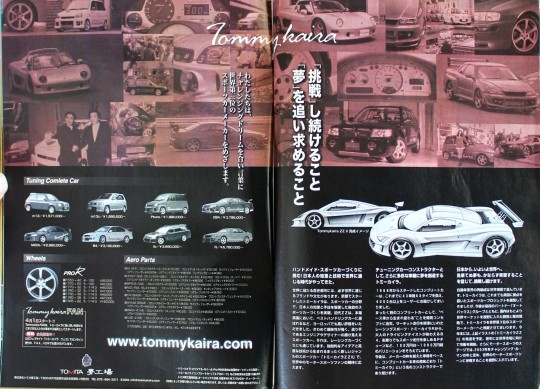

Tommykaira
Continue to "challenge" Pursue your "dream"
With “challenging dream” as a slogan
We aim to be the world's third largest sports car manufacturer.
Taking on the challenge of making a handmade sports car! The time has come when Japanese wisdom and technology can be used worldwide.
World-renowned historical cities always have world- class brands and cultures. Tommykaira, which started in Kyoto, has realized the creation of unique sports cars in the field of sports cars, making full use of Japanese wisdom and techniques. The first generation ZZ was highly acclaimed in Europe as well, being recognized as the best handling car in the UK. A sports car with an extremely strong sense of taste, where you can see the faces of the engineers and designers who built it. This also applies to the production of racing cars. We will meet the expectations of motor sports fans around the world with the Tommykaira ZZ11, a completely new genre of sports car bom from creative ideas and advanced
As a tuning car constructor, Tommykaira creates dreams for even more diverse car models.
Since its launch in 1988, we have
produced 43 models and 68 types of complete cars, delivering more than 4,000 units to users
Pursuing the development concept of "A "reborn as a completely different complete
car from a race car". From the racing sports Tommykaira R aimed at circuit driving. you can enjoy adult driving taste B4, Enjoy sports driving even in city driving P We have variations ranging from 1 million yen to 10 million yen, such as tunes From now on, we will continue to be a constructor named "Tommykaira " in the original meaning of a complete car, based on models that transcend the framework of manufacturers.
From Japan to the world. We will
continue to take on challenges, believing that even unimaginable dreams will come true.
The restructuring of the automotive industry is progressing on a global scale. Tommykaira has so far I developed a sports car project based in the UK, but from now on, together with our best partner, the AUTOBACS group, we will develop and sell products with a view to the global market as well as the domestic market, to become the world's third largest sports car manufacturer At the end of this year, we plan to announce the "Tommykaira ZZII shown in the above illustration, and start marketing it for the global market in the following year. Furthermore, on the motorsports stage, 2003 has been designate as the year of Challenging Le Mans, with the aim of participating in the world's motorsports scene
16 notes
·
View notes
Text
A totally different kind of calculator
My latest purchase for The Collection, a Calculated Industries ConversionCalc Plus, was mainly to further diversify my collection, as I now want to get calculators from as many distinct manufacturers as possible. As the name suggests, it's a calculator that is entirely dedicated to the task of converting between different measurements.

I picked the conversion calculator because it is by far the least specialised of all of CI's calculators and just about the only one I could imagine being actually useful to me.
After getting it, it's one of my favourite calculators ever and it goes on my desk rather than on the drawers with most of the calculator collection. I use it whenever I have unit conversions to do because it's so much more convenient than opening a new tab and typing conversions into Google, especially because Google converts to feet with a decimal point by default, instead of feet and inches:

Look Google! It's how people expect feet measurements to be formatted!
Most unit conversions are two button presses away because there's no need to type out their names or dig through menus, everything's at the base or shifted layers of the keypad. I would never use my other calculators for this purpose because they don't prioritise it enough to be faster than Google. It's faster to type "1435 mm to ft" into Google than find the conversions menu in my fx-9750Gii and use submenus every time to slowly type out "[mm] -> [ft]":

After all that effort, it still won't present it in feet and inches!
It of course works as a normal calculator, but has some odd limitations, such as lacking cubes and cube roots. Squares and square roots are elegantly integrated into the unit conversion system. Squaring a metre value will turn it into square metres, and taking the square root of an area will show you the side length of a square with that area, automatically changing from square measurements to linear ones. But none of this can happen with the cubic measurements. Oh well.
Unfortunately, this calculator doesn't support the UK imperial system. All imperial units are the US versions. This is not a huge problem for me as the vast majority of the time I use this calculator will be for communication with Americans.
Converting between units never loses precision. If you convert a number into a new unit, all of the digits of the original unit are retained no matter how many conversions you do afterward. This even applies to entering fractional amounts of inches, which has a special "/" (that is, not the usual divide symbol) button on the calculator. Fractions automatically get converted into a fraction with a power of 2 denominator, but when shown as a decimal value, are clearly still their original value rather than rounded. This is really impressive.
Another great part of the calculator's interface is the unusual number of edge cases built in to display as many digits as possible at all times. If needed, the calculator repurposes its scientific notation/fraction digits into a bonus pair of digits after the decimal place:

I thought this was a bug when I first saw it!
It also has a fourteen-segment display to the left of the main seven-segment display, the first calculator in my collection to feature one. This is used for some of the measurements that don't have dedicated segments in the LCD. But it can also display the minus sign, so MILE ends up dropping the E in sufficiently long negative numbers:

Notice here that it's also using the uppermost segment of the last digit as a minus sign for the scientific notation digits. This seems to suggest that these are not intended to show scientific notation and were originally designed to display inches with fractions, and were then repurposed for scientific notation:

In general, the interface shows an incredibly creative approach to using the LCD panel that I've never seen on any other calculator. Looking through CI's range, some of their other calculators seem to feature a similar or possibly identical display, which suggests it's a standard one that they reuse for all of their calculators.
My collection is now at 19 calculators and I have every major type of calculator:
Standard
Financial
Programmer
Scientific
Graphing
I would consider this another category from all of those, the "unit converter" calculator type. Just as scientific calculators often include programmer functionality in their BASE-N modes, this is definitely not something that this calculator is uniquely capable of, but it is something it's uniquely capable in. It is to unit conversion what my DM16L is to BASE-N arithmetic and logic.
Having a totally new kind of calculator is rare and exciting with a collection my size, which is why I've found the CI converter calculator so much more interesting than my other recent additions, which have been scientific and graphing calculators.
It ticks boxes for my calculator collecting, is genuinely useful to me and has a very unusual set of capabilities and user interface. Love it when that happens!
Calculated Industries website
3 notes
·
View notes
Text
Something that really fascinates me is the concept of “American words”. You know, words that US Americans associate with the USA, and the pandering way in which this used. I’m specifically looking at this in the context of trains.
For the longest time, with very few exceptions, the rail industry has used numeric or alphanumeric codes to refer to vehicles. Some trains got nicknames, but for the most part, you talk about SD40-2 and GG1 and GP9 and Re 4/4 II and 141R and F40PH and LNER A4 and class 95 and V100 (east) and DD 16 and BB 15000 and what have you. Stuff that makes you sound crazy to any non-railfan, and that’s how we like it. None of these are made up, by the way, I have all of them in my model railroad collection (the 141R is new).
That’s because this is all a strictly business-to-business thing. Nobody buys a particular locomotive, car or train because of the great name or advertisement, they do it because they ran the numbers and a lot of negotiating.
Over the years, however, that shifted. The first major time (apart from a few one-off named trains) in the US was probably the General Electric P40, P42 and P32, collectively known as “Genesis”. That’s already a fairly “American” word: Explicitly biblical, which is less popular in Europe (let alone other parts of the world), and it sounds meaningful: Something something start, new beginning. The locomotive is the beginning of the train, anyway, so it’s not like it’s wrong.
In Europe, we’ve seen this in full force during the 90s and especially 2000s, together with a huge shift in how railroading worked at all. Before, it used to be that the rail industry of one country got together with the country’s main railroad, and designed one locomotive together, and everyone got to build at least parts of it. A lot of mergers and liberalisation of the rail market means that nowadays, the rail industry is organised as multinational corporations (I’d say four major ones at the moment, but I won’t say which ones so nobody gets angry at me for saying the wrong ones), and these design the trains in house and then try to sell them, with real marketing departments and such.
For example, in the 80s and early 90s, there was exactly one regional diesel train that was being built in Germany, the class 628. It was only built for Germany (mostly, a few ended up in Luxembourg), too. Other countries had very similar trains, notably the Netherlands and Austria, which were derived from the German design and built under license, but by their own local rail industry to their own standards.
On the other hand, by 2000, in the same market (but now low-floor for better accessibility and climatized), we had things like the class 642, 643, 646 and 648, and that’s not counting the weird ones (such as the shorter 640, 641 and 650) or the ones only sold to private companies. All of them did the same thing, but all of them were built by different companies (Siemens, Bombardier, Stadler and Alstom in order), and all of them were also exported, unchanged, to many other countries around the world. Even North America got a small set of each of these types.
And since there were many, it was decided that marketing was now in order. These trains no longer only had class numbers from the railroad that ordered them; instead they got names from their manufacturers. In those cases, Coradia LINT, TALENT, GTW and Desiro, and there were also RegioShuttle, RegioSprinter and Itino, and yes I am missing some on purpose.
Throughout the 2000s, all manufacturers adopted this for almost all trains and locomotives. So let’s talk about the names in particular.
First thing: Names are expensive, so they get reused. You will find Siemens Desiro trains in Germany, Belgium, the UK and Malaysia (among others), and those have nothing to do with each other except for being regional trains built by Siemens. In fact, there are two or three completely different types of Desiro in Germany alone (the Desiro ML and HC are not completely different, but they’re hardly the same thing either). They are generally delineated by suffixes, like Desiro Classic, Desiro ML, Desiro HC, or Coradia LINT and Coradia Stream and many others.
Second: Names are generally abstract made-up words. It’s okay if they sound a bit English or are English, but they’re generally meaningless. Desiro, Coradia, TRAXX, Vectron, Talent, Velaro, Avelia, Urbos, Flexity, Civity, Mireo, those are all names that vaguely imply something but mean nothing in particular and are specifically chosen to be inoffensive everywhere.
The big exception to this is Stadler, who uses funny (to them) abbreviations. Their line-up includes TANGO (tram), WINK (local train), FLIRT (regional train), KISS (double-decker regional and intercity train), and for their high-speed long-distance train… SMILE. I’ve said it before and I’ll say it again: They’re cowards.
So let’s come back to North America. The passenger rail industry there has been in a zombie state for a long time, and it seems like the freight industry is starting to join them. The market is too small to really have a domestic industry, so with very few exceptions, all modern trams, subways, locomotives and complete train sets are European designs, adapted for the US market, but assembled in the US due to federal laws.
And they all get names for the specific North American variant, and this name is always what I’d call an “American word”:
Europe: Siemens Vectron DE (diesel locomotive). North America: Siemens Charger
Europe: Citadis (tram). North America: Citadis Spirit
Europe: Flexity 2 (tram). North America: Flexity Freedom
Europe: Avelia Horizon (high speed train). North America: Avelia Liberty
There are still some exceptions, like the ALP45DP whose name is as gloriously ugly as the locomotive itself, but the trend is clear.
Just today, and the reason why I’m posting this, we got my favorite example. The company behind the privately owned and operated high speed line between (the suburbs of) Los Angeles and Las Vegas is currently looking at which trains to buy, and Siemens has released an official proposal. It’s based on their Velaro high speed train, specifically the Velaro Novo that’s conceptually a cross between the ICE 3 (new) and ICE 4 (remind me to write a post about ICE types and their bonkers numbering one of these days), and for a long time it has only been communicated as such. But their competitor has the much more American name Avelia Liberty (also known as the new Acela by its operator Amtrak - interestingly Acela would be a perfectly good European train name). So they needed to not only build a better train, they also needed to out-american them on the name. Apparently.
Enter the American Pioneer 220.
Now that’s an American name! Velaro Pioneer would have been a very American name already, but Siemens really wants that contract, so they put American in front, just to make it absolutely clear that they’re not planning to sell this one to Iceland. The 220 stands for its top speed of 354 kilometers per hour, of course, which it won’t reach on the proposed line.
So what is an “American” word here? I’d say it’s anything you can have as a keyword in a speech about how great and unique the US is. In the list above, we have Freedom, Freedom but in Latin, Spirit, Charger and now Pioneer.
For more similar names, I think the space program provides great opportunities. All Space Shuttles and Mars rovers have great American names. Anything that sounds like can-do attitude, overcoming, exploring new grounds, being super-free and perhaps vaguely metaphysical can do the job. Opportunity. Constitution. Eagle. Flag. Banner. Crossroads. Star. You can just go on.
I suppose/hope we’re not getting any trained named Columbia anymore, but I do hope Destiny is still in there and that Stadler gets in on this act, because a train named KISS Destiny would be absolutely hilarious.
I think there’s like a 5% chance of someone coming in my notes and saying that this is necessary and good because the US are so full of freedom and liberty and work-ethic and so on that the Europeans could never understand. I don’t think it’ll happen, I’ve made the post far too long for anyone to read through to the end, but you know, if it does: I don’t really agree with that. But it is true that US Americans like to believe that about themselves, and so if you want to pander to them, these words work wonders.
As a non-american who has spent less than three months in the US in total, I am not an expert on this or in fact anything I’m saying here, but I also personally blame George Bush and the Iraq War, and the rise in mandated patriotism that came with that. Of course the land of Freedom Fries also gets the Trainionity Freedom. See also how many US trains now have American flags on them, including many that were built fully in Germany or Switzerland. That’s a relatively recent thing.
2 notes
·
View notes
Text
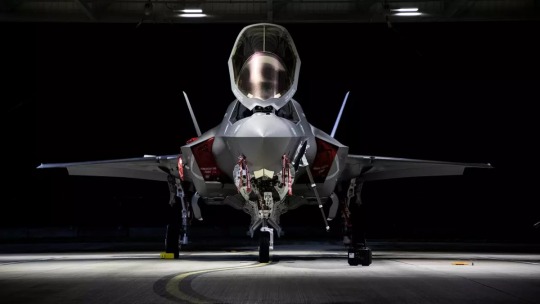
BAE Systems delivers the thousandth fuselage of the F-35 Lightning II to Lockheed Martin
Fernando Valduga By Fernando Valduga 02/08/23 - 16:00 in Military
BAE Systems delivered the thousandth rear fuselage to the Lockheed Martin for the F-35, the most advanced and capable fifth-generation fighter in the world.
More than 1,500 employees at the company's premises in Samlesbury, Lancashire, produce the rear fuselage for each F-35 of the global fleet. The first fuselage was delivered to Lockheed Martin in 2005.
“This is a significant moment for everyone involved in the program and a proof of the highly qualified workforce we have in northwestern England,” said Cliff Robson, managing director of the BAE Systems Air group, at an event celebrating the 1000th delivery today. “Our role in the F-35 program is another example of how we make a substantial contribution to the UK’s local and national economy and help provide capacity that is critical to national security.”
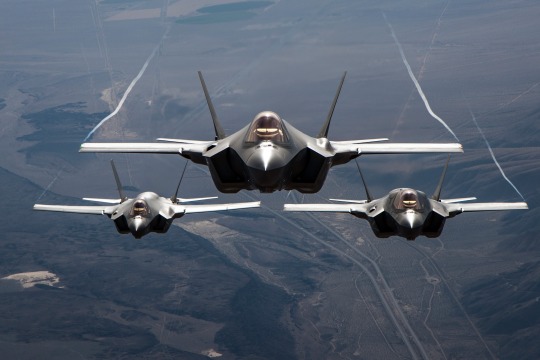
The three variants of the F-35 in flight.
“The F-35 program drives UK economic growth and prosperity by injecting approximately £41 billion into the UK economy and supporting more than 20,000 jobs in the UK supply chain, many of them based in the northwest of the country,” said Bridget Lauderdale, vice president of Lockheed Martin and general manager of the F-35 program. “With more than 500 companies in our supply chain in the United Kingdom, we are proud of the role that our partnership with BAE Systems has in supplying the world’s most advanced aircraft to the United Kingdom and 17 other allied nations.”
BAE Systems has been involved in the F-35 program since its inception and plays important roles in the development, manufacture and maintenance of the aircraft, which is operated by the Royal Air Force, Royal Navy and air forces around the world.

F-35B of the joint fleet of RAF and British Royal Navy.
“This is an important milestone for our business and demonstrates the experience of our people and their commitment to fulfilling the F-35 program,” said Susan Addison, senior vice president of U.S. programs at BAE Systems Air. "The functions we perform today are supported by a world-class manufacturing pedigree and industrial know-how in the United Kingdom, which has been developed over decades of cutting-edge experience in aerial combat programs. We are proud of what we do for our customers and the air forces that help keep us safe."
The record global F-35 program totals more than 3,000 F-35s among the 17 customers of the program. Work on the program will continue at BAE Systems' advanced manufacturing center in Samlesbury for many years.
Tags: Military AviationBAE SystemsF-35 Lightning IILockheed Martin
Fernando Valduga
Fernando Valduga
Aviation photographer and pilot since 1992, he participated in several events and air operations, such as Cruzex, AirVenture, Dayton Airshow and FIDAE. He has works published in specialized aviation magazines in Brazil and abroad. He uses Canon equipment during his photographic work in the world of aviation.
Related news
VANT - UAV
MQ-9 drones rented by the Indian Navy exceeded 10,000 flight hours in just two years
08/02/2023 - 14:00
Air-to-air refueling is a precision maneuver conducted according to tactics, techniques and procedures that both pilots and crew regularly practice. (Photo: SHAPE/Tom Evans)
MILITARY
German Eurofighters train air refueling with multinational A330 MRTT fleet
08/02/2023 - 13:00
INCIDENTES
Man invades Air Force One base in the US and shots are fired
08/02/2023 - 11:00
WAR ZONES
VIDEO AND IMAGES: Iran officially reveals underground air base, the "Eagle 44"
08/02/2023 - 08:51
MILITARY
NORAD says it does not have the ability to track Chinese balloons in real time
07/02/2023 - 21:54
BRAZILIAN AIR FORCE
YANOMANI: C-98 FAB Caravan has already transported 40 tons of supplies to Surucucu
07/02/2023 - 19:02
Cavok Twitter
homeMain PageEditorialsINFORMATIONeventsCooperateSpecialitiesadvertiseabout
Cavok Brazil - Digital Tchê Web Creation
Commercial
Executive
Helicopters
HISTORY
Military
Brazilian Air Force
Space
Specialities
Cavok Brazil - Digital Tchê Web Creation
9 notes
·
View notes